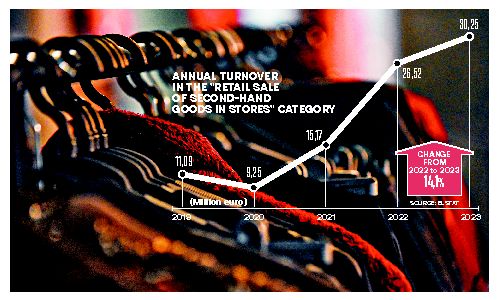Guided by sustainability and the search for quality products, consumers are increasingly turning to the growing market for second-hand clothing. The increased demand for second hand clothes, which has been an international trend for several years, is reflected in data published by the Greek statistical authority (ELSTAT).
According to this data, “Retail sales of second-hand goods in stores” stood at 11.09 million euros in 2019. This figures rose to 15.1 million euros in 2021 before soaring to 26.52 million euros in 2022. The sector’s upward trend continued in 2023, when total turnover reached EUR 30.35 million, a year-on-year increase of 14.1% compared to the already booming 2022.

And while these figures may not relate exclusively to clothing, there can be no doubt that the now well-established second-hand clothing market has captured a significant slice of the consumer pie. Given households’ dwindling disposable income, consumers now visit the host of shops that have opened in Greece and abroad in search of the highest possible quality at the lowest possible price.
In addition, the “they don’t make them like they used to” mindset is becoming ever more common, as the majority of the clothes these shops sell are considered vintage. But when did second-hand clothes become trendy, and who’s buying them? “The second-hand clothing market has gained a lot of ground in Greece over the last five years.

Konstantina Soldatou
It has become particularly popular among people aged 15 to 25, which is to say Generation Z. Although it has always been there, it’s quite mainstream now and has crossed over into pop culture,” Konstantina Soldatou, the owner of a vintage clothing store in Pangrati, explains to TO BHMA. As she says, in the two years since she opened the business, sales has been steadily increasing.
The market is driven by quality and the circular economy
Motivated ever more by the ethical imperative to recycle, young people’s consumer choices are increasingly guided by environmental considerations. Theofilos Aslanidis, director of the Greek Knitwear and Ready-to-wear Businesses Association, views this as another factor in the rapid rise of the second-hand market: “It has dual drivers: more conscious consumption on the one hand, and lower cost on the other. There is a more environmentally-aware consumer who would rather give a second chance to a product that has been used and not burden the planet any further than buy a cheap mass-produced garment that they will wear for a few years then throw away. The consumer who wants to respect the environment prefers to buy a—theoretically—better quality garment that would have ended up in a landfill than a new one whose production will have an environmental impact in the form of additional energy and water consumption.”

Athina Vafiadou
Athina Vafiadou, who also owns a vintage shop in downtown Athens, is of the opinion that the majority of consumers focus on quality and price over environmental factors: “A second-hand garment may no longer be the most economical solution. A good vintage piece could be the same price as a new one, but the quality will definitely be far higher. So I’d say that most people opt for second-hand for reasons of quality.” She notes that the search for the pieces she sells in her store pushes up the cost, as does their rarity: “Every two to three months, I travel abroad to specific countries and suppliers. There, I look through what they have on offer and pick out the best products in the best possible condition. Of course, this pushes up my costs. But other factors also contribute to the final price, including how hard it is to find a garment, how old it is and what condition it is in.”
Konstantina Soldatou adds that there is still, nonetheless, “a hint of a stigma attached to second-hand clothes, as a lot of people think that something used will automatically be dirt cheap. Still, slowly but surely, the message is getting through that vintage has value, too. You can find beautiful, high-quality designer pieces at far lower prices than you would if buying new.” She is convinced the market will continue to flourish, as “there are millions of tons of clothing available out there.”
New trends
Following the trend, large clothing store chains have been quick to launch programs allowing consumers to sell and buy second-hand clothes of particular brands, while individuals are also taking advantage of the opportunities provided by social media. “Designer brands are giving their customers this opportunity in an effort to attract younger consumers and to build an image in line with the new social musts. As far as individuals are concerned, it is a new way of thinking for many people who want to give their clothes a second chance, while getting a little money back at the same time,” Theophilos Aslanidis concludes.






